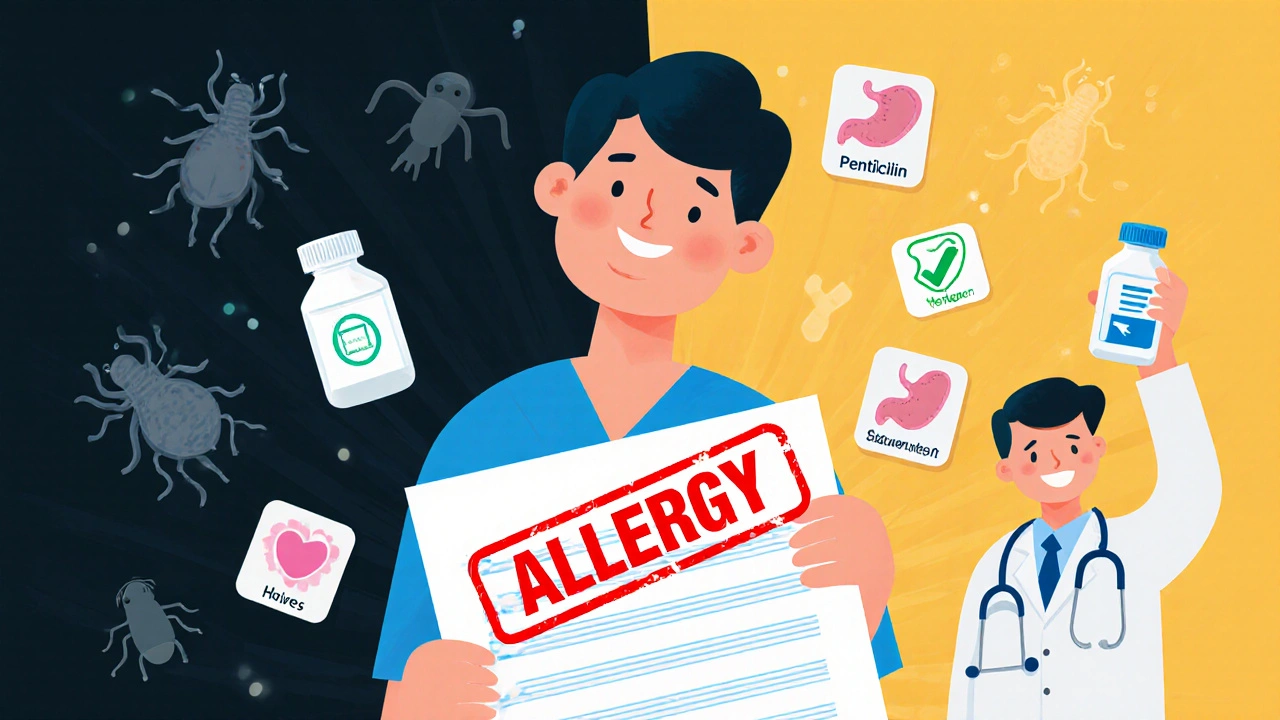
Penicillin Allergy Assessment Tool
Your Reaction Assessment
Key Information
Did you know? 95% of people who think they're penicillin allergic are actually NOT allergic.
True allergy occurs within 1 hour and causes hives, swelling, or breathing trouble. Delayed rashes or GI symptoms are typically side effects.
Without testing, you're 45% more likely to get C. diff infection and face higher mortality risks.
Most people can safely take penicillin after proper testing.
More than 10% of people in the U.S. say they’re allergic to penicillin. But here’s the thing: penicillin allergy is one of the most commonly misdiagnosed conditions in medicine. If you’ve been told you’re allergic, there’s a very good chance you’re not. And that mistake could be costing you more than just time-it could be putting your health at risk.
What’s Really Going On When You Say ‘I’m Allergic to Penicillin’?
People often label any bad reaction to penicillin as an “allergy.” But not every unpleasant side effect is an immune system response. In fact, most aren’t. A true penicillin allergy means your immune system sees the drug as a threat. It produces IgE antibodies that trigger mast cells to release histamine and other chemicals. That’s what causes hives, swelling, trouble breathing, or even anaphylaxis-life-threatening reactions that happen fast, usually within minutes to an hour after taking the drug. But here’s what most people don’t realize: if you had a rash, stomach upset, or headache after taking penicillin as a kid, you probably didn’t have an allergy. You had a side effect. Side effects are common. About 5-10% of people get mild nausea. Around 1-2% get diarrhea. Vaginal yeast infections happen too. These aren’t signs your body is attacking the drug. They’re just unwanted, usually harmless, side effects of how penicillin interacts with your gut bacteria or other systems. The problem? Once you’re labeled “allergic,” that tag sticks. Even if you haven’t taken penicillin in 20 years. Even if your reaction was a harmless rash from a virus you had at the same time.Why Mislabeling Penicillin as an Allergy Is Dangerous
When doctors think you’re allergic to penicillin, they avoid it. That sounds safe-but it’s not. Instead of giving you penicillin, which is cheap, effective, and targeted, they turn to broader-spectrum antibiotics like vancomycin, clindamycin, or fluoroquinolones. These drugs kill more than just the infection. They wipe out good bacteria too. And that opens the door for dangerous superbugs. The CDC reports that patients with fake penicillin allergies are 45% more likely to get a Clostridioides difficile infection-a severe, sometimes deadly, gut infection. They’re also more likely to develop MRSA, a resistant staph infection that’s hard to treat. And it’s not just about infections. A 2019 study in the Journal of Allergy and Clinical Immunology found that people with mislabeled penicillin allergies had 6 more deaths per 1,000 patients within a year of hospitalization than those who could safely take penicillin. The financial cost is huge too. One hospital admission for someone with a fake allergy costs about $1,000 more than one where penicillin was used. That’s because broader antibiotics are pricier, hospital stays are longer, and complications require more treatment.How to Tell the Difference: Allergy vs. Side Effect
Not all reactions are created equal. Here’s how to tell what you really had:- True allergy (IgE-mediated): Happens fast-within minutes to an hour. Symptoms include hives, swelling of lips/tongue/throat, wheezing, low blood pressure, vomiting, or anaphylaxis. Requires epinephrine. This is rare-less than 1% of people who say they’re allergic actually have this.
- Delayed reaction (non-IgE): Shows up days later. A flat, red, itchy rash (maculopapular) is common. Fever, joint pain, or swelling can happen too. These are often caused by viruses, not penicillin. Even if you got a rash, it doesn’t mean you’re allergic.
- Side effect: Nausea, diarrhea, mild headache, or yeast infection. These happen without immune involvement. They’re annoying, but not dangerous. And they don’t mean you’re allergic.
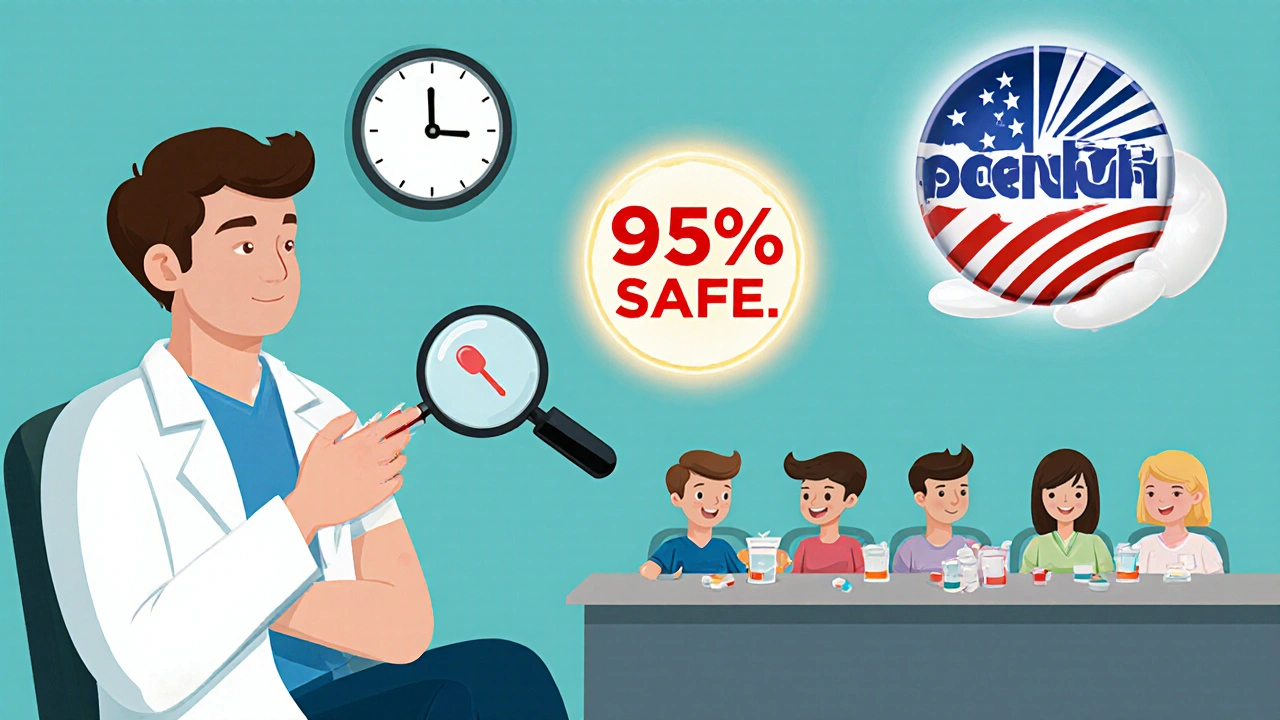
Testing for Penicillin Allergy: It’s Safer Than You Think
There’s a simple, proven way to find out if you’re truly allergic: skin testing followed by an oral challenge. Here’s how it works:- History review: Your doctor or allergist asks detailed questions about your reaction-when it happened, what symptoms you had, how long it lasted, and whether you needed emergency treatment.
- Skin test: A tiny amount of penicillin (and a control) is placed under your skin. If you’re truly allergic, a red, itchy bump appears within 15-20 minutes. This test is safe and highly accurate.
- Oral challenge: If the skin test is negative, you take a small dose of amoxicillin (a penicillin-type drug) under observation. You’re watched for an hour. If nothing happens, you’re cleared.
Why So Few People Get Tested
If it’s safe and accurate, why aren’t more people getting tested? One reason: fear. A 2021 survey found that 32% of people refused testing because they were scared of having a reaction. But the risk is tiny-less than 1 in 1,000. Another reason: doctors don’t refer. A 2022 study showed that only 39% of primary care doctors knew that delayed rashes are rarely true allergies. Many still assume any rash = allergy. And insurance? It’s a mess. Some plans don’t cover allergist visits. Others require referrals you can’t get. In one Reddit thread, a user said it took 15 years and $15,000 in extra medical bills before they finally got tested. But things are changing. In 2023, Medicare increased reimbursement for penicillin skin testing by 37%. Hospitals are starting to build programs. The CDC and University of Pennsylvania even created a free smartphone app-PAAT-that helps doctors decide who needs testing.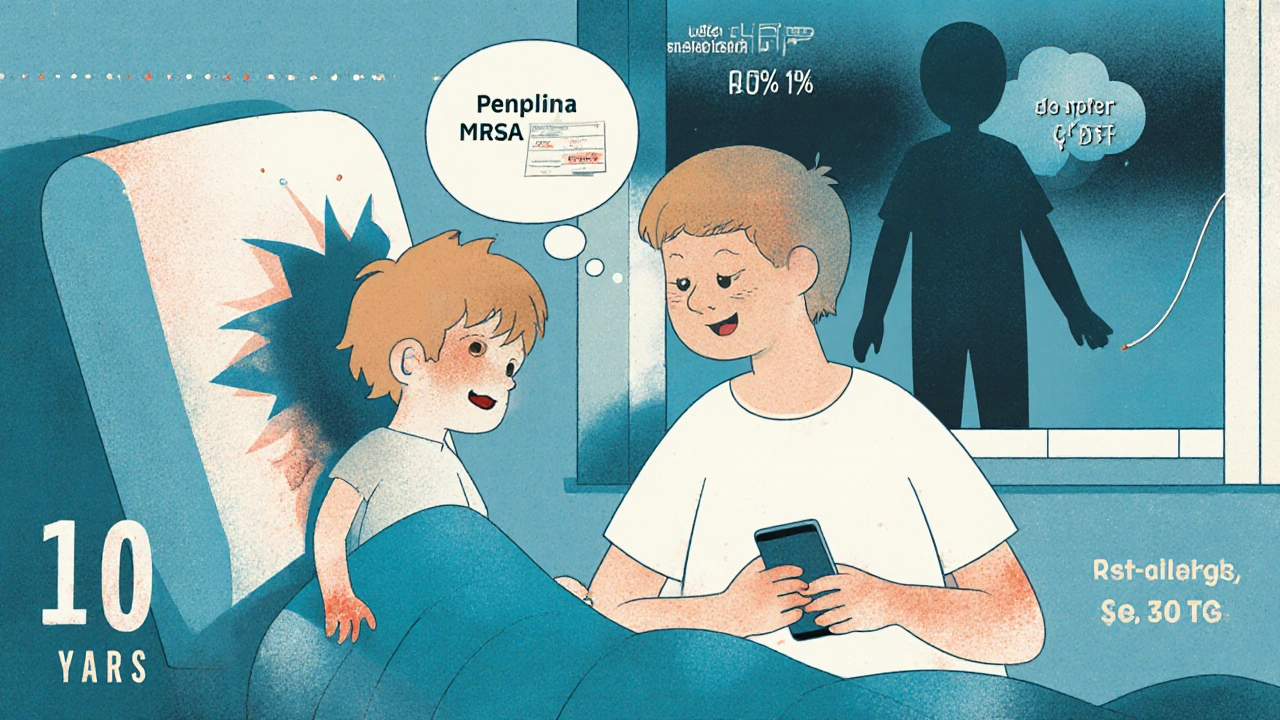
What You Should Do Now
If you’ve ever been told you’re allergic to penicillin:- Don’t assume it’s true. Ask yourself: Did I have hives or trouble breathing within an hour? Or was it a rash that showed up days later? Did I just feel sick to my stomach?
- If your reaction was mild or delayed, talk to your doctor about getting tested. You don’t need to see an allergist unless your reaction was severe.
- If you’re unsure, ask: “Can I be evaluated for a penicillin allergy?” Many clinics now offer this as part of routine care.
- If you’ve never taken penicillin since your childhood reaction, you’re even more likely to have outgrown it. Studies show 80% of people lose their allergy after 10 years.
The Future of Penicillin Allergy
By 2025, hospitals will be required to track how often they use penicillin instead of broader antibiotics. That’s because the government is now tying reimbursement to how well they manage antibiotic use. Electronic health records like Epic are starting to flag patients with old allergy labels and prompt doctors to reconsider. In just a few years, being labeled “penicillin allergic” might be as outdated as saying you’re allergic to aspirin because you got a stomach ache once. The truth? Penicillin is one of the safest, most effective antibiotics we have. But only if you’re allowed to use it. Don’t let a childhood mistake keep you from the best treatment. Ask. Get tested. Be sure.Can you outgrow a penicillin allergy?
Yes. About 80% of people who had a true penicillin allergy as a child lose their sensitivity after 10 years. Even if you had a severe reaction back then, your immune system may no longer react to the drug. That’s why testing is recommended for anyone with a past label, no matter how long ago it happened.
Is a rash always a sign of penicillin allergy?
No. A rash that appears days after starting penicillin is often caused by a virus you already had, not the drug. In fact, up to 90% of these rashes are not allergic. True allergic rashes usually appear within an hour and are raised, itchy, and clearly hives. A flat, red rash that spreads slowly is rarely IgE-mediated.
What if I had anaphylaxis to penicillin years ago?
If you had a confirmed anaphylactic reaction, you should still avoid penicillin unless evaluated by an allergist. However, even in these cases, testing can be done safely under strict supervision. Many people with past anaphylaxis have been successfully re-challenged without incident. Never assume you’re still allergic without professional testing.
Can I take other antibiotics if I’m allergic to penicillin?
Yes, but only if you’re truly allergic. If you’re mislabeled, you’re being denied the best option. Many people labeled allergic to penicillin can safely take cephalosporins (like cephalexin) or amoxicillin-even if they had a rash. Cross-reactivity is rare, especially with modern antibiotics. Always get tested before avoiding entire classes of drugs.
Is penicillin allergy testing covered by insurance?
In the U.S., most insurance plans now cover penicillin skin testing and oral challenges, especially since Medicare increased reimbursement in 2023. However, you may need a referral from your doctor. If your provider says no, ask for a copy of the AAAAI or CDC guidelines on penicillin de-labeling-many clinics now follow them as standard practice.
What happens if I test negative but still feel sick taking penicillin?
If you test negative and still get side effects like nausea or diarrhea, those are not allergies-they’re just common drug reactions. Your doctor can still prescribe penicillin and may suggest taking it with food or adding probiotics to reduce stomach upset. You’re not allergic-you just need to manage the side effects.


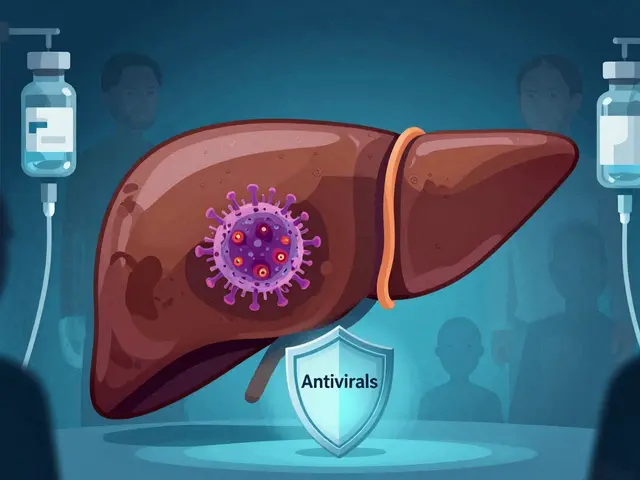

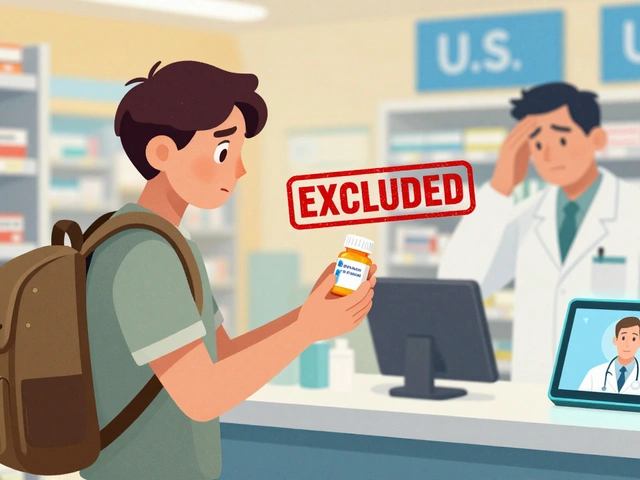

13 Comments
Look, I get it - everyone’s scared of antibiotics now. But if you’re still calling that rash you got at 12 ‘allergic’ because your mom panicked, you’re part of the problem. I’m a veteran. I’ve seen guys die because we gave them vancomycin instead of penicillin. Stop being lazy. Get tested. It’s 2025, not 1995.
OMG I JUST REALIZED I’M ONE OF THOSE PEOPLE 😱 I got a rash when I was 8 after amoxicillin and now I can’t even get a sinus infection treated right. I’m booking an appointment tomorrow. Thank you for this!! 🙏💊
so like… i had a rash and diarrhea after penicillin and now i’m ‘allergic’? lol. i think my doc just wrote it down because i was crying and they didn’t wanna deal. now i get flagged in the system every time. i’ve been on azithromycin 3x this year. my stomach hates me. 🤢
I’m a nurse and I’ve seen this over and over. Patients come in with ‘penicillin allergy’ on their chart and it’s usually a stomach ache from 20 years ago. We’ve started doing rapid testing right in the clinic. It takes 45 minutes. Zero reactions. 90% of them get cleared. Why aren’t we doing this everywhere? It’s cheaper, safer, and smarter.
Let’s be real: the medical-industrial complex doesn’t want you to know this. Why? Because broad-spectrum antibiotics? They’re expensive. And they’re profitable. Penicillin? A few cents. Meanwhile, your insurance gets billed $1,200 for a 5-day course of clindamycin. And guess who pays? You. And your premiums. And your kids’ future healthcare. This isn’t medicine - it’s a cash grab disguised as caution.
There’s something deeply human about how we cling to labels - even when they’re wrong. We don’t just say ‘I’m allergic’ - we say ‘I am allergic.’ It becomes part of our identity. But medicine doesn’t work that way. Biology doesn’t care about your story. It cares about antibodies. And if those faded? You’re not broken. You’re just… untested. The real tragedy isn’t the misdiagnosis. It’s that we’ve normalized living with unnecessary fear.
YES. This is the kind of info that needs to be screamed from the rooftops. I’m telling my whole family. My sister’s still avoiding all penicillins because of a rash she got as a toddler. She’s on antibiotics that make her dizzy and nauseous. She doesn’t even know she’s being set back on purpose. Let’s change this.
Okay but what if it’s a conspiracy? 🤔 What if the pharmaceutical companies are hiding the fact that penicillin is too cheap and they want you to buy the expensive stuff? I mean, think about it - if everyone got tested and cleared, how many billions would they lose? 🤑 I’m not saying I’m allergic… but I’m not taking any chances either. #BigPharma
While I appreciate the intent of this article, I must respectfully emphasize that the clinical protocols surrounding antibiotic de-labeling require careful adherence to established guidelines, particularly in the context of comorbidities and prior anaphylactic events. The assertion that 95% of patients are mislabeled, while statistically compelling, must be contextualized within individual risk stratification and institutional protocols. A one-size-fits-all approach to de-labeling may inadvertently compromise patient safety in vulnerable populations.
I had a rash when I was 6. I’m 42 now. Never had another reaction. Never got tested. I just assumed I was allergic. But then last year I got pneumonia and they gave me amoxicillin anyway - said ‘you’re probably fine.’ I took it. No problem. No rash. No hives. Just a little tummy upset. Now I wonder - was I ever allergic? Or was I just a kid who got sick and got a rash from the virus? I feel like I’ve been living with a ghost.
Man, I’ve been telling my GP this for years. I got a rash in college - turned out it was mono. But now I’m labeled ‘allergic’ and every time I need an antibiotic, they give me something that wrecks my gut. I finally got tested last month. Negative. Took penicillin like it was water. Best feeling ever. If you’ve been told you’re allergic - don’t just accept it. Ask. Push. It’s worth it.
What if the real allergy isn’t to penicillin… but to being told what to believe? What if the ‘allergy’ is just a symptom of a medical system that labels people instead of listening to them? I got a rash. I was 7. I cried. They wrote ‘penicillin allergy.’ I never questioned it. But now I wonder - was I allergic… or just unheard?
Interesting. But let’s not pretend this is new. I’ve been working in Indian public health for 18 years. We’ve known this for decades. But here, people don’t get tested because they can’t afford the clinic. They don’t get referrals because there are no allergists. They just get a prescription for something else. And die of C. diff because the only thing they can get is a cheap, broad-spectrum antibiotic that’s been overused since 2003. So yes - the science is right. But the system? Still broken. Testing won’t fix that.